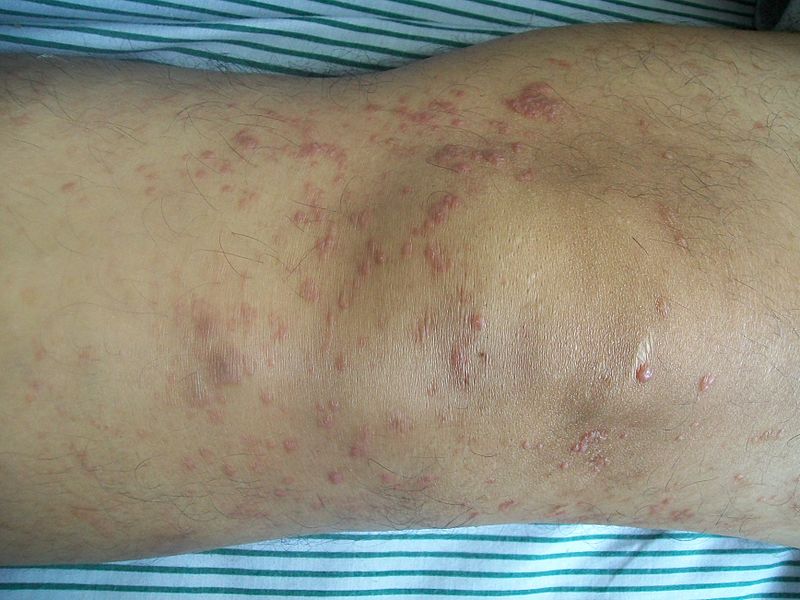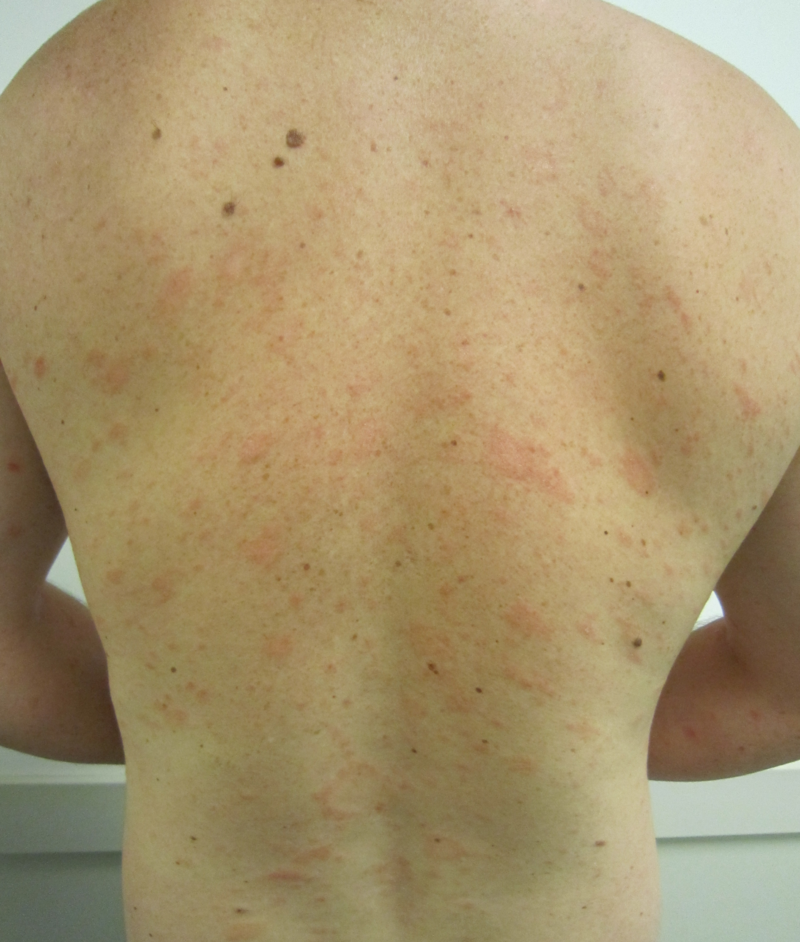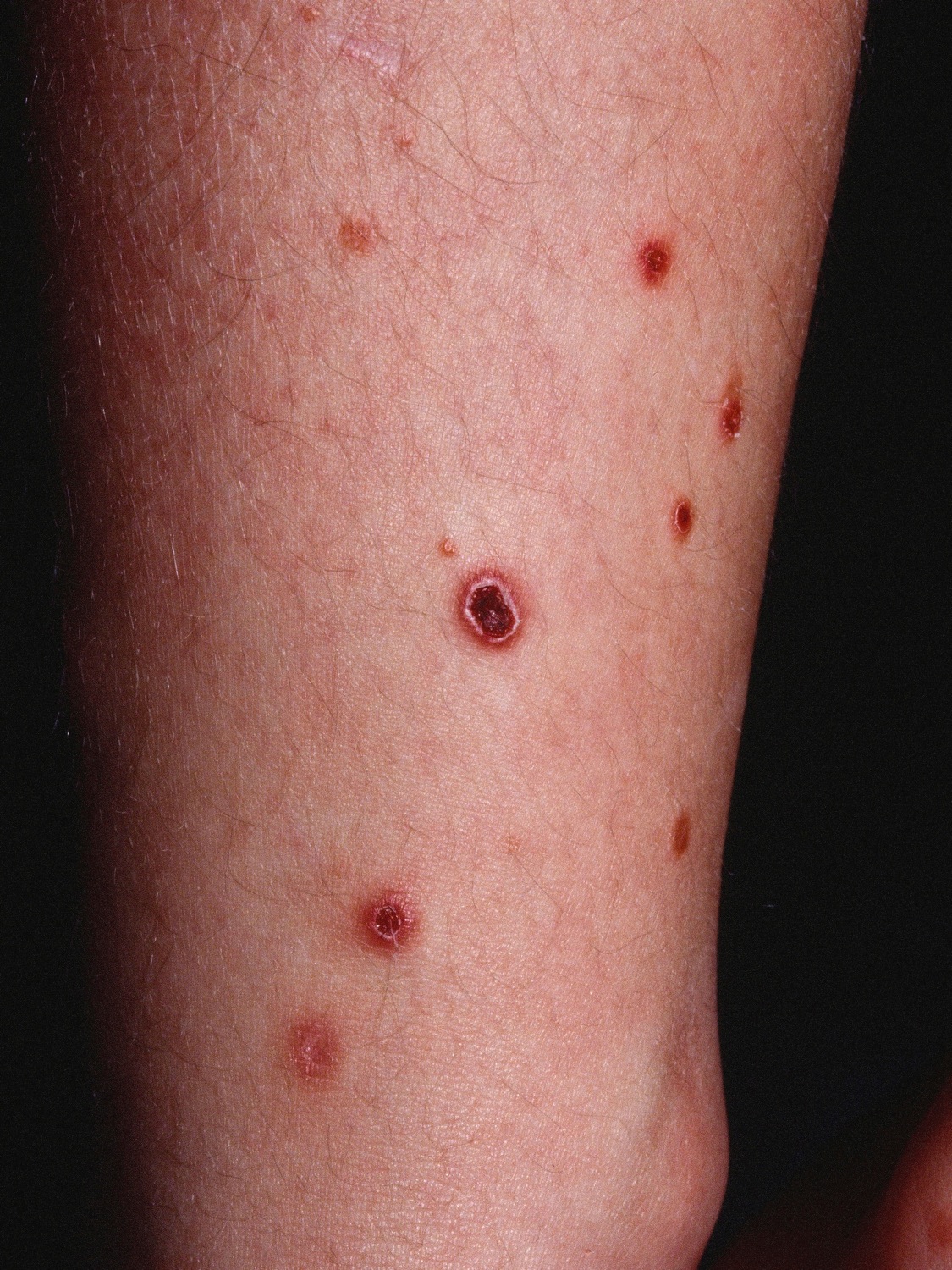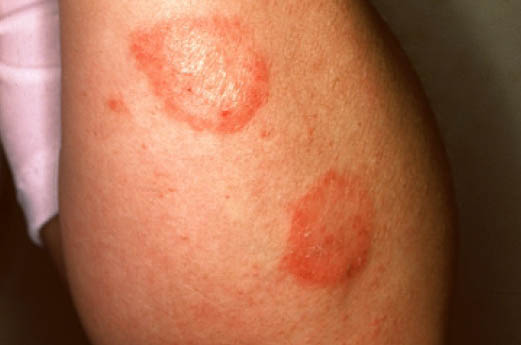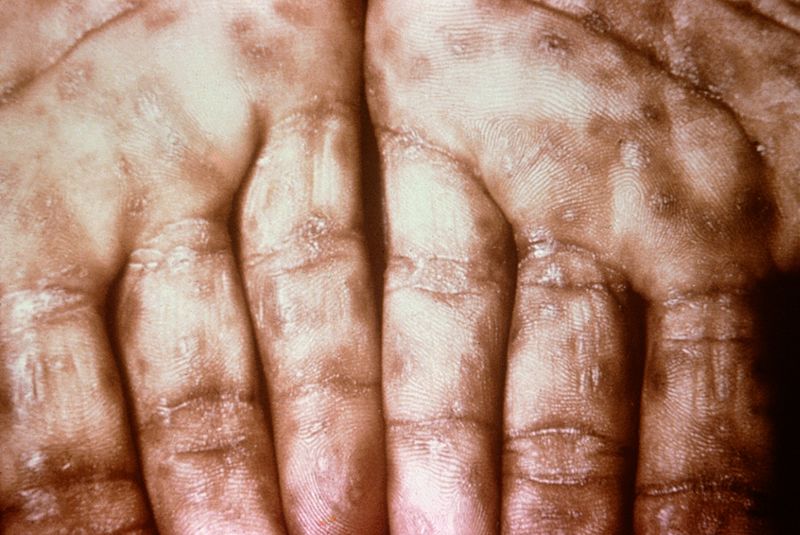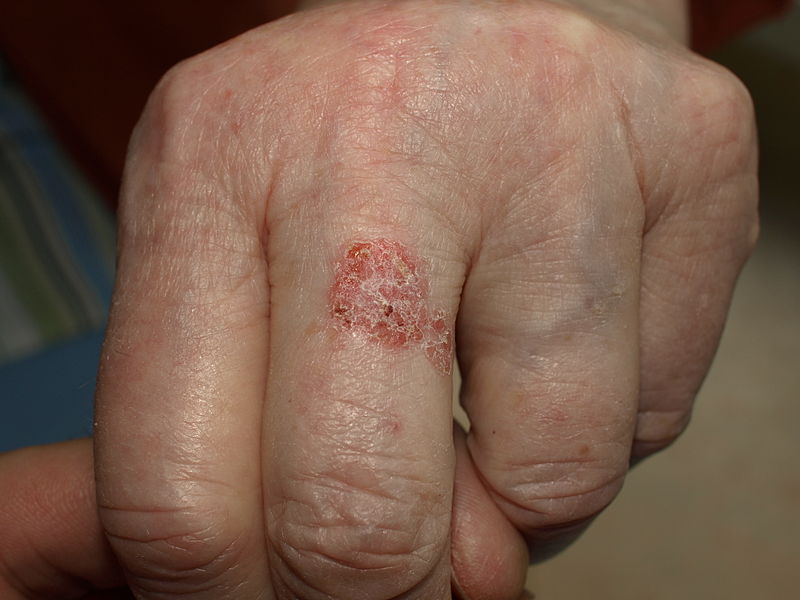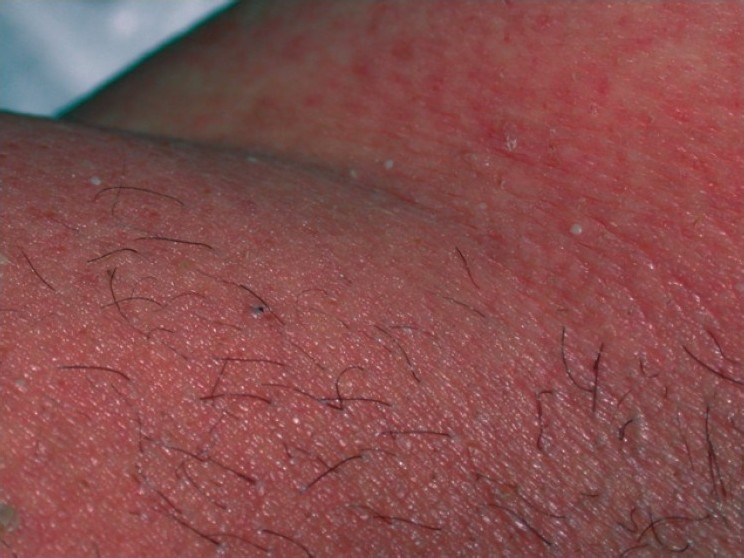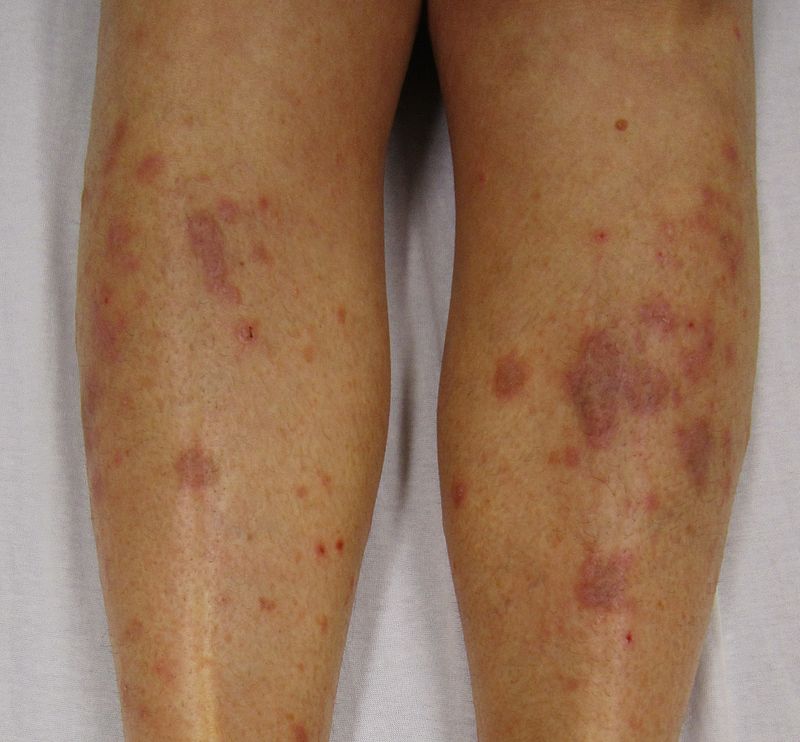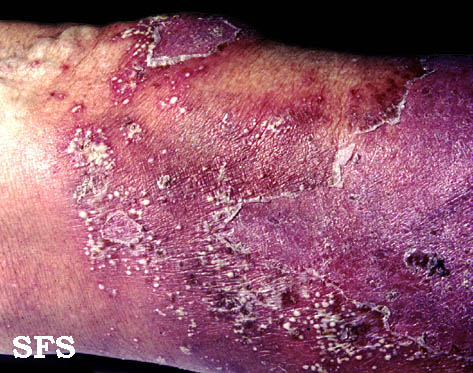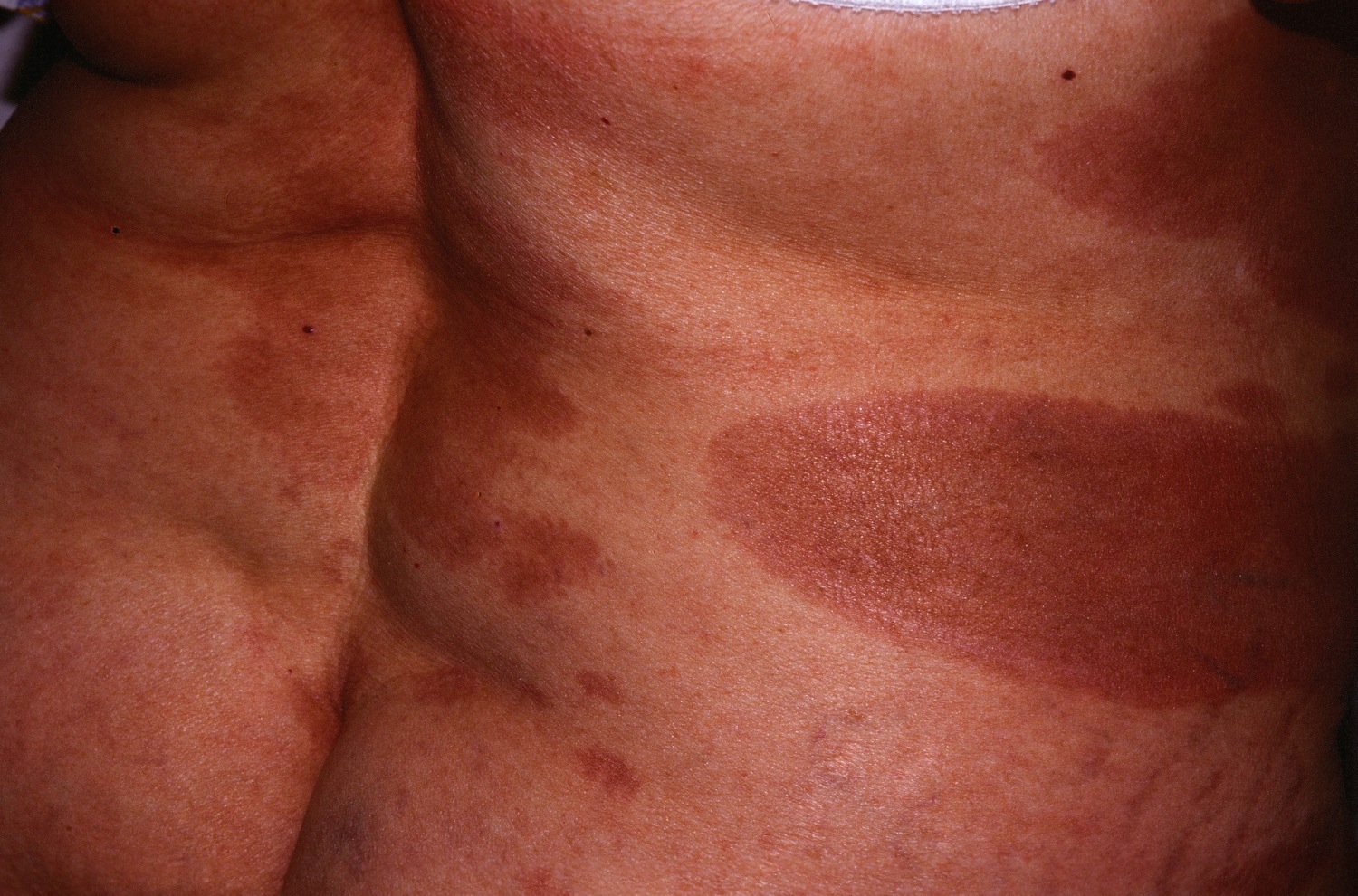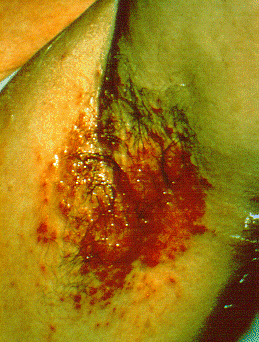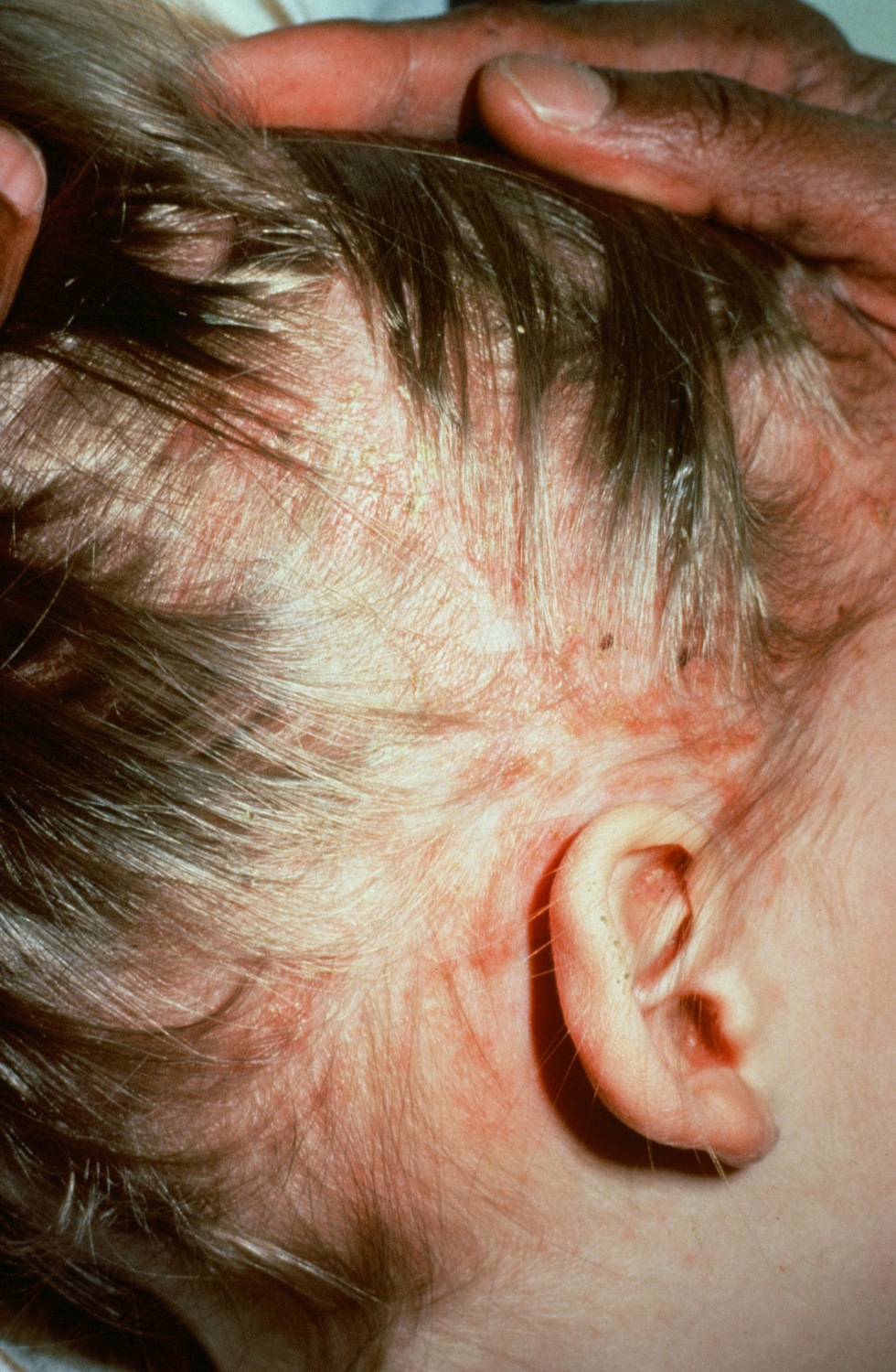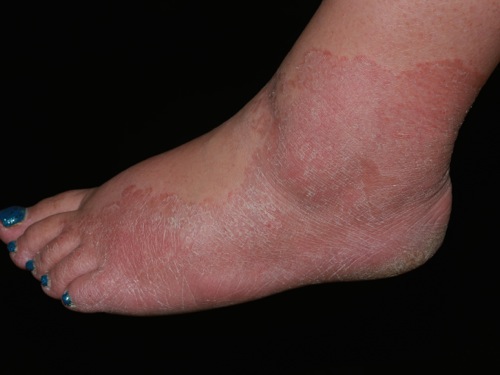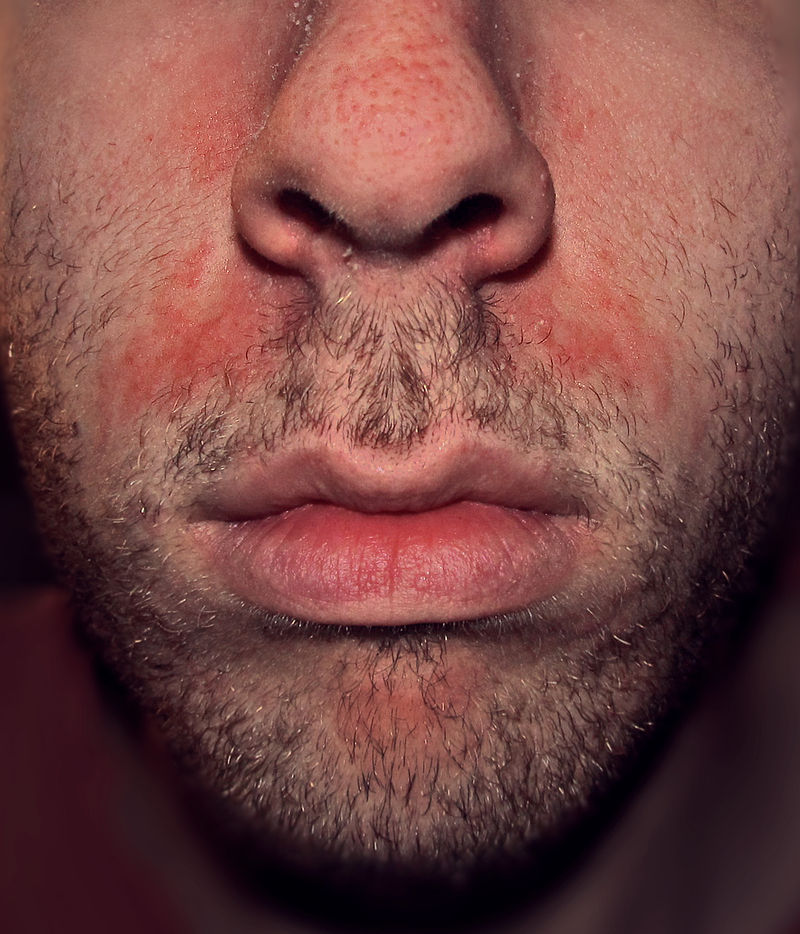Drug allergy differential diagnosis: Difference between revisions
| (11 intermediate revisions by 2 users not shown) | |||
| Line 1: | Line 1: | ||
__NOTOC__ | __NOTOC__ | ||
{{CMG}} {{AE}} {{CP}} | {{CMG}} {{AE}} {{CP}} | ||
{{Drug allergy}} | {{Drug allergy}} | ||
==Overview== | ==Overview== | ||
True drug allergy needs to be differentiated from other reactions caused by [[drugs]], such as pseudoallergic reactions and drug induced [[autoimmune]] like reactions. Drug allergy also needs to be differentiated from other conditions and reactions that present similarly to drug allergy. | |||
==Differentiating Drug Allergy from Other | ==Differentiating Drug Allergy from Other Diseases== | ||
===Pseudoallergic Reactions=== | ===Pseudoallergic Reactions=== | ||
| Line 20: | Line 17: | ||
*[[NSAIDS]] | *[[NSAIDS]] | ||
*[[ | *[[Vancomycin]] | ||
*[[ | *[[Local anesthetics]] | ||
*[[ | *[[Radiocontrast agents]] | ||
*[[ | *[[Opiates]] | ||
*[[ | *[[Chemotherapeutics]] | ||
*[[ | *[[Monoclonal antibodies]] and other biologic therapies used in [[cancer]] treatment | ||
===Auto-immune Like Syndromes Caused by Drugs=== | ===Auto-immune Like Syndromes Caused by Drugs=== | ||
[[Lupus]] like syndromes can be caused by the following medications; | [[Lupus]] like syndromes can be caused by the following medications; | ||
*[[ | *[[Penicillamine]] | ||
*[[ | *[[Procainamide]] | ||
*[[ | *[[Phenytoin]] | ||
*[[ | *[[Isoniazid]] | ||
*[[ | *[[Sulfasalazine]] | ||
*[[ | *[[Amiodarone]] | ||
*[[ | *[[Minocycline]] | ||
A pemphigus like syndrome can be caused by [[penicillamine]] | A pemphigus like syndrome can be caused by [[penicillamine]] | ||
IgA bullous dermatitis can be caused by: | IgA bullous dermatitis can be caused by: | ||
*[[ | *[[Vancomycin]] | ||
*[[ | *[[Ceftriaxone]] | ||
*[[ | *[[Ciprofloxacin]] | ||
*[[ | *[[Metronidazole]] | ||
===IgE Mediated Drug Allergies=== | |||
Certain [[IgE]] mediated conditions need to be differentiated from IgE mediated drug allergies ([[angioedema]], [[urticaria]], [[anaphylaxis]], bronschospasm) <ref name="pmid22165859">{{cite journal |author=Warrington R, Silviu-Dan F |title=Drug allergy |journal=Allergy Asthma Clin Immunol |volume=7 Suppl 1 |issue= |pages=S10 |year=2011 |pmid=22165859 |pmc=3245433 |doi=10.1186/1710-1492-7-S1-S10 |url=}}</ref>; | |||
===IgE Mediated Drug Allergies== | |||
Certain IgE mediated conditions need to be differentiated from IgE mediated drug allergies ([[angioedema]], [[urticaria]], [[anaphylaxis]], bronschospasm); | |||
*[[Insect bites]] and stings | *[[Insect bites]] and stings | ||
*[[Carcinoid syndrome]] | *[[Carcinoid syndrome]] | ||
| Line 58: | Line 52: | ||
*[[Mastocytosis]] | *[[Mastocytosis]] | ||
*[[Infection]] ([[EBV]], gastrointestinal [[parasites]], [[hepatitis A]], [[hepatitis B]], and [[hepatitis C]] | *[[Infection]] ([[EBV]], gastrointestinal [[parasites]], [[hepatitis A]], [[hepatitis B]], and [[hepatitis C]] | ||
===Non-IgE Mediated Drug Allergies=== | |||
Certain non-IgE mediated conditions need to be differentiated from non-IgE mediated allergic reactions (exanthema, drug rash with eosinophilia and systemic symptoms (DRESS) syndrome, Stevens-johnson syndrome ([[SJS]]), toxic epidermal necrolysis ([[TEN]]). | |||
*[[Kawasaki disease]] | |||
*[[Still's disease]] | |||
*Acute [[graft-versus-host disease]] | |||
*[[Psoriasis]] | |||
*Insect bites/ stings | |||
* [[Streptococcal]] infection | |||
*[[Viral infection]] | |||
===Differentiating drug allergy from other rashes=== | |||
Drug allergy should be differentiated from other diseases causing papulosquamous or erythmatosquamous rash. The differentilas include: | |||
{| class="wikitable" | |||
! align="center" style="background:#4479BA; color: #FFFFFF;" + |Disease | |||
! align="center" style="background:#4479BA; color: #FFFFFF;" + |Rash Characteristics | |||
! align="center" style="background:#4479BA; color: #FFFFFF;" + |Signs and Symptoms | |||
! align="center" style="background:#4479BA; color: #FFFFFF;" + |Associated Conditions | |||
! align="center" style="background:#4479BA; color: #FFFFFF;" + |Images | |||
|- | |||
| style="background: #DCDCDC; padding: 5px; text-align: center;" |[[Cutaneous T cell lymphoma]]/[[Mycosis fungoides]]<ref name="urlMycosis Fungoides and the Sézary Syndrome Treatment (PDQ®)—Patient Version - National Cancer Institute">{{cite web |url=https://www.cancer.gov/types/lymphoma/patient/mycosis-fungoides-treatment-pdq |title=Mycosis Fungoides and the Sézary Syndrome Treatment (PDQ®)—Patient Version - National Cancer Institute |format= |work= |accessdate=}}</ref> | |||
| | |||
* '''Premycotic phase:''' A scaly, red [[rash]] in areas of the [[body]] that usually are not exposed to the sun. This rash does not cause symptoms and may last for months or years. | |||
* '''Patch phase:''' Thin, [[erythematous]], [[eczema]]-like rash. | |||
* '''[[Plaque]] phase:''' Small raised [[Bumps on skin|bumps]] ([[Papule|papules]]) or hardened [[lesions]] on the skin, which may be [[erythematous]]. | |||
* '''[[Tumor]] phase:''' Tumors form on the [[skin]]. [[Infection]] secondary to [[Ulcer|ulcers]]. | |||
| | |||
* [[Epidermis (skin)|Epidermal]] [[atrophy]] or poikiloderma | |||
* Generalized [[itching]] ([[pruritus]]) | |||
* [[Pain]] in the affected area of the skin | |||
* [[Insomnia]] | |||
* Red ([[erythematous]]) patches scattered over the [[skin]] of the [[trunk]] and the [[extremities]] | |||
* Tumor-like lobulated outgrowths form on the skin in the latter phase of the disease | |||
* [[Weight loss]] | |||
* [[Lymphadenopathy]] | |||
* [[Malaise]] and [[fatigue]] | |||
* [[Anemia]] | |||
* May progress to [[Sezary syndrome]] (skin involvement plus hematogenous dissemination) | |||
| | |||
* [[Sezary syndrome]] | |||
| | |||
[[Image:Mycosis_fungoides.JPG|200px|courtesy of wikipedia.org]] | |||
|- | |||
| style="background: #DCDCDC; padding: 5px; text-align: center;" |[[Pityriasis rosea]]<ref name="pmid27512182">{{cite journal |vauthors=Mahajan K, Relhan V, Relhan AK, Garg VK |title=Pityriasis Rosea: An Update on Etiopathogenesis and Management of Difficult Aspects |journal=Indian J Dermatol |volume=61 |issue=4 |pages=375–84 |year=2016 |pmid=27512182 |pmc=4966395 |doi=10.4103/0019-5154.185699 |url=}}</ref> | |||
| | |||
* Pink or salmon in color, which may be scaly; referred to as "herald patch" | |||
* Oval shape | |||
* Long axis oriented along the cleavage lines | |||
* Distributed on the [[trunk]] and [[proximal extremities]] | |||
* Squamous marginal collarette and a “fir-tree” or “Christmas tree” distribution on posterior trunk | |||
* Secondary to [[viral infection]]<nowiki/>s | |||
* Resolves spontaneously after 6-8 weeks | |||
| | |||
* Preceded by a prodrome of: | |||
** [[Sore throat]] | |||
** [[Gastrointestinal tract|Gastrointestinal]] disturbance | |||
** [[Fever]] | |||
** [[Arthralgia]] | |||
| | |||
* Infection by any of the following:<ref name="pmid19997691">{{cite journal |vauthors=Prantsidis A, Rigopoulos D, Papatheodorou G, Menounos P, Gregoriou S, Alexiou-Mousatou I, Katsambas A |title=Detection of human herpesvirus 8 in the skin of patients with pityriasis rosea |journal=Acta Derm. Venereol. |volume=89 |issue=6 |pages=604–6 |year=2009 |pmid=19997691 |doi=10.2340/00015555-0703 |url=}}</ref> | |||
** [[Human herpesvirus 6|HHV-6]] | |||
** [[HHV-7]] | |||
** [[HHV-8]] | |||
| | |||
[[Image:Pityriasisrosea.png|200px|courtesy of https://commons.wikimedia.org]] | |||
|- | |||
| style="background: #DCDCDC; padding: 5px; text-align: center;" |[[Pityriasis lichenoides chronica]] | |||
| | |||
* Recurrent [[lesions]] are usually less evenly scattered than in cases of psoriasis | |||
* Brownish red or orange-brown in color | |||
* [[Lesions]] are capped by a single detachable, opaque, mica-like scale | |||
* Often leave [[Hypopigmented area|hypopigmented]] [[Macule|macules]] | |||
| | |||
* High [[fever]] | |||
* [[Malaise]] | |||
* [[Myalgias]] | |||
* [[Paraesthesia]] | |||
* [[Pruritis|Pruritus]] | |||
| | |||
* Infection by any of the following:<ref name="pmid9109005">{{cite journal |vauthors=Smith KJ, Nelson A, Skelton H, Yeager J, Wagner KF |title=Pityriasis lichenoides et varioliformis acuta in HIV-1+ patients: a marker of early stage disease. The Military Medical Consortium for the Advancement of Retroviral Research (MMCARR) |journal=Int. J. Dermatol. |volume=36 |issue=2 |pages=104–9 |year=1997 |pmid=9109005 |doi= |url=}}</ref> | |||
** [[Epstein Barr virus|Epstein-Barr virus]] (EBV) | |||
** ''[[Toxoplasma gondii]]'' | |||
** [[Human Immunodeficiency Virus (HIV)|Human immunodeficiency virus]] (HIV) | |||
| | |||
[[Image:PLEVA2.jpg|200px|courtesy of http://www.regionalderm.com]] | |||
|- | |||
| style="background: #DCDCDC; padding: 5px; text-align: center;" |[[Nummular dermatitis]]<ref name="pmid23517392">{{cite journal |vauthors=Jiamton S, Tangjaturonrusamee C, Kulthanan K |title=Clinical features and aggravating factors in nummular eczema in Thais |journal=Asian Pac. J. Allergy Immunol. |volume=31 |issue=1 |pages=36–42 |year=2013 |pmid=23517392 |doi= |url=}}</ref> | |||
| | |||
* Multiple coin-shaped [[Eczematous Scaling|eczematous]] [[lesions]] | |||
* Commonly affecting the [[extremities]] (lower>upper) and [[trunk]] | |||
* May ooze [[fluid]] and become dry and crusty | |||
| | |||
* Often appears after a skin injury, such as a [[burn]], [[abrasion]] (from friction), or [[insect bite]] | |||
* [[Lesions]] commonly relapse after occasional remission or may persist for long periods | |||
* [[Pruritis|Pruritus]] | |||
| | |||
* Associated with: | |||
** Dry skin | |||
** Emotional stress | |||
** [[Allergens]] (rubber chemicals, [[formaldehyde]], [[neomycin]], chrome, [[Mercury (element)|mercury]], and [[nickel]]) | |||
** [[Staphylococcus]] infection | |||
** Seasonal variation | |||
** [[Alcohol]] | |||
** [[Drugs]] | |||
** [[Atopy]] | |||
| | |||
[[Image:Nummular dermatitis dry.jpg|200px|courtesy of your-doctor.net dermatology atlas]] | |||
|- | |||
| style="background: #DCDCDC; padding: 5px; text-align: center;" |[[Secondary syphilis]]<ref name="urlSTD Facts - Syphilis">{{cite web |url=https://www.cdc.gov/std/syphilis/stdfact-syphilis.htm |title=STD Facts - Syphilis |format= |work= |accessdate=}}</ref> | |||
| | |||
* Round, coppery, red colored [[lesions]] on palms and soles | |||
* [[Papule|Papules]] with collarette of scales | |||
| | |||
* [[Fever]] | |||
* [[Lymphadenopathy|Generalized lymphadenopathy]] | |||
* [[Sore throat]] | |||
* [[Hair loss|Patchy hair loss]] | |||
* [[Headaches|Headache]] | |||
* [[Weight loss]] | |||
* [[Myalgia]] | |||
* [[Fatigue]] | |||
| | |||
* Associated with: | |||
** [[Condyloma latum|Condylomata lata]] | |||
** Corona verinata | |||
** Positive [[Venereal disease research laboratory (VDRL) test|VDRL]] test | |||
| | |||
[[Image:Secondary_Syphilis.jpg|200px|courtesy of wikipedia.org]] | |||
|- | |||
| style="background: #DCDCDC; padding: 5px; text-align: center;" |[[Bowen’s disease]]<ref name="pmid28523295">{{cite journal |vauthors=Neagu TP, Ţigliş M, Botezatu D, Enache V, Cobilinschi CO, Vâlcea-Precup MS, GrinŢescu IM |title=Clinical, histological and therapeutic features of Bowen's disease |journal=Rom J Morphol Embryol |volume=58 |issue=1 |pages=33–40 |year=2017 |pmid=28523295 |doi= |url=}}</ref> | |||
| | |||
* [[Erythematous]], small, scaly plaque, which enlarges erratically over time | |||
* Scale is usually yellow or white and it is easily detachable without any [[bleeding]] | |||
* Well-defined margins | |||
| | |||
* [[Pruritis|Pruritus]] | |||
* [[Pain]] | |||
* Bleeding [[lesions]] | |||
| | |||
* Associated with:<ref name="pmid25201325">{{cite journal |vauthors=Murao K, Yoshioka R, Kubo Y |title=Human papillomavirus infection in Bowen disease: negative p53 expression, not p16(INK4a) overexpression, is correlated with human papillomavirus-associated Bowen disease |journal=J. Dermatol. |volume=41 |issue=10 |pages=878–84 |year=2014 |pmid=25201325 |doi=10.1111/1346-8138.12613 |url=}}</ref> | |||
** [[Erythroplasia of Queyrat]] ([[Bowen's disease]] of the [[penis]]) | |||
** [[Squamous cell carcinoma]] | |||
** Solar radiation and [[ultraviolet]] (UV) exposure | |||
** [[Radiation therapy|Radiotherapy]] | |||
** [[Immunosuppression]] | |||
** [[Arsenic]] exposure | |||
** [[Human papillomavirus|Human papilloma virus]] (HPV) type 16 | |||
** [[Polyomavirus|Merkel cell polyomavirus]] | |||
** [[Sjögren's syndrome|Sjögren’s syndrome]] | |||
| | |||
[[Image:Bowen.jpg|200px|courtesy of wikipedia.org]] | |||
|- | |||
| style="background: #DCDCDC; padding: 5px; text-align: center;" |[[Exanthematous pustulosis]]<ref name="pmid26354880">{{cite journal |vauthors=Szatkowski J, Schwartz RA |title=Acute generalized exanthematous pustulosis (AGEP): A review and update |journal=J. Am. Acad. Dermatol. |volume=73 |issue=5 |pages=843–8 |year=2015 |pmid=26354880 |doi=10.1016/j.jaad.2015.07.017 |url=}}</ref> | |||
| | |||
* Numerous small, primarily non-follicular, sterile [[pustules]], arising within large areas of [[Edema|edematous]] [[erythema]] | |||
| | |||
* [[Fever]] | |||
* [[Leukocytosis]] | |||
* Intracorneal, subcorneal, and/or intraepidermal [[pustules]] with [[papillary]] [[dermal]] [[edema]] containing [[neutrophils]] and [[eosinophils]] | |||
| | |||
* Associated with:<ref name="pmid12466124">{{cite journal |vauthors=Schmid S, Kuechler PC, Britschgi M, Steiner UC, Yawalkar N, Limat A, Baltensperger K, Braathen L, Pichler WJ |title=Acute generalized exanthematous pustulosis: role of cytotoxic T cells in pustule formation |journal=Am. J. Pathol. |volume=161 |issue=6 |pages=2079–86 |year=2002 |pmid=12466124 |pmc=1850901 |doi=10.1016/S0002-9440(10)64486-0 |url=}}</ref> | |||
** [[Antibiotics]] ([[Penicillin|penicillins]], [[sulfonamides]], [[tetracyclines]]) | |||
** [[Carbamazepine]] | |||
** [[Calcium channel blocker|Calcium channel blockers]] ([[Diltiazem]]) | |||
** [[Hydroxychloroquine]] | |||
| | |||
[[Image:Acute_generalized_exanthematous_pustulosis.jpg|200px|commons.wikimedia.org]] | |||
|- | |||
| style="background: #DCDCDC; padding: 5px; text-align: center;" |[[Lichen planus|Hypertrophic lichen planus]]<ref name="pmid27222766">{{cite journal |vauthors=Ankad BS, Beergouder SL |title=Hypertrophic lichen planus versus prurigo nodularis: a dermoscopic perspective |journal=Dermatol Pract Concept |volume=6 |issue=2 |pages=9–15 |year=2016 |pmid=27222766 |pmc=4866621 |doi=10.5826/dpc.0602a03 |url=}}</ref> | |||
| | |||
* Classically involves shin and ankles and is characterized by [[Hyperkeratosis|hyperkeratotic]] [[Plaque|plaques]] and [[Nodule (medicine)|nodules]] covered by a scale | |||
* [[Lesions]] may transform into [[Hyperkeratosis|hyperkeratotic]] thickened, elevated, purplish or reddish [[Plaque|plaques]] and [[nodules]] | |||
| | |||
* Chronic [[pruritis|pruritus]] | |||
* Scaling | |||
* May be [[asymptomatic]] | |||
| | |||
* Associated with [[Hepatitis C virus]] infection<ref name="pmid19770446">{{cite journal |vauthors=Shengyuan L, Songpo Y, Wen W, Wenjing T, Haitao Z, Binyou W |title=Hepatitis C virus and lichen planus: a reciprocal association determined by a meta-analysis |journal=Arch Dermatol |volume=145 |issue=9 |pages=1040–7 |year=2009 |pmid=19770446 |doi=10.1001/archdermatol.2009.200 |url=}}</ref> | |||
| | |||
[[Image:Lichen_planus2.JPG|200px|courtesy of wikipedia.org]] | |||
|- | |||
| style="background: #DCDCDC; padding: 5px; text-align: center;" |Sneddon–Wilkinson disease<ref name="pmid9564592">{{cite journal |vauthors=Lutz ME, Daoud MS, McEvoy MT, Gibson LE |title=Subcorneal pustular dermatosis: a clinical study of ten patients |journal=Cutis |volume=61 |issue=4 |pages=203–8 |year=1998 |pmid=9564592 |doi= |url=}}</ref> | |||
| | |||
* [[Flaccid]] [[pustules]] that are often generalized and have a tendency to involve the flexural areas | |||
* Annular configuration | |||
| | |||
* [[Pruritis|Pruritus]] | |||
* May be asymptomatic | |||
| | |||
* Associated with: | |||
** [[Monoclonal gammopathy]], usually an [[IgA]] paraproteinemia<ref name="pmid3056995">{{cite journal |vauthors=Kasha EE, Epinette WW |title=Subcorneal pustular dermatosis (Sneddon-Wilkinson disease) in association with a monoclonal IgA gammopathy: a report and review of the literature |journal=J. Am. Acad. Dermatol. |volume=19 |issue=5 Pt 1 |pages=854–8 |year=1988 |pmid=3056995 |doi= |url=}}</ref> | |||
** [[Crohn's disease]]<ref name="pmid1357895">{{cite journal |vauthors=Delaporte E, Colombel JF, Nguyen-Mailfer C, Piette F, Cortot A, Bergoend H |title=Subcorneal pustular dermatosis in a patient with Crohn's disease |journal=Acta Derm. Venereol. |volume=72 |issue=4 |pages=301–2 |year=1992 |pmid=1357895 |doi= |url=}}</ref> | |||
** [[Osteomyelitis]] | |||
** [[Adalimumab]]<ref name="pmid23489057">{{cite journal |vauthors=Sauder MB, Glassman SJ |title=Palmoplantar subcorneal pustular dermatosis following adalimumab therapy for rheumatoid arthritis |journal=Int. J. Dermatol. |volume=52 |issue=5 |pages=624–8 |year=2013 |pmid=23489057 |doi=10.1111/j.1365-4632.2012.05707.x |url=}}</ref> | |||
| | |||
[[Image:Sneddon wilkinson disease 03.jpeg|200px|courtesy http://www.atlasdermatologico.com.br/disease.jsf?diseaseId=427]] | |||
|- | |||
| style="background: #DCDCDC; padding: 5px; text-align: center;" |[[Parapsoriasis|Small plaque parapsoriasis]]<ref name="pmid7026622">{{cite journal |vauthors=Lambert WC, Everett MA |title=The nosology of parapsoriasis |journal=J. Am. Acad. Dermatol. |volume=5 |issue=4 |pages=373–95 |year=1981 |pmid=7026622 |doi= |url=}}</ref> | |||
| | |||
* [[Erythematous]] [[plaques]] with fine scaly surface | |||
* May present with elongated, finger-like patches | |||
* Symmetrical distribution on the flanks | |||
* Known as digitate dermatosis | |||
| | |||
* [[Lesions]] may be [[asymptomatic]] | |||
* May be mildly [[Itch|pruritic]] | |||
* May fade or disappear after sun exposure during the summer season, but typically recur during the winter | |||
| | |||
* May progress to [[mycosis fungoides]]<ref name="pmid16191852">{{cite journal |vauthors=Väkevä L, Sarna S, Vaalasti A, Pukkala E, Kariniemi AL, Ranki A |title=A retrospective study of the probability of the evolution of parapsoriasis en plaques into mycosis fungoides |journal=Acta Derm. Venereol. |volume=85 |issue=4 |pages=318–23 |year=2005 |pmid=16191852 |doi=10.1080/00015550510030087 |url=}}</ref> | |||
| | |||
[[Image:Small_plaque_parapsoriasis.jpg|200px|courtesy http://www.regionalderm.com]] | |||
|- | |||
| style="background: #DCDCDC; padding: 5px; text-align: center;" |[[Intertrigo]]<ref name="pmid16156342">{{cite journal |vauthors=Janniger CK, Schwartz RA, Szepietowski JC, Reich A |title=Intertrigo and common secondary skin infections |journal=Am Fam Physician |volume=72 |issue=5 |pages=833–8 |year=2005 |pmid=16156342 |doi= |url=}}</ref> | |||
| | |||
* Red and fleshy looking [[lesion]] in [[skin]] folds | |||
* [[Itching]] | |||
* Oozing | |||
* May be sore | |||
| | |||
* [[Pruritis|Pruritus]] | |||
* Musty odor | |||
| | |||
* Associated with: | |||
** [[Infections]] (Fungal, bacterial, viral) | |||
** [[Allergies]] | |||
** [[Diabetes Mellitus|Diabetes]] | |||
** [[Obesity]] | |||
| | |||
[[Image:Axillary_intertrigo.png|200px|courtesy of cdc.gov]] | |||
|- | |||
| style="background: #DCDCDC; padding: 5px; text-align: center;" |[[Langerhans cell histiocytosis]]<ref name="pmid18577030">{{cite journal |vauthors=Satter EK, High WA |title=Langerhans cell histiocytosis: a review of the current recommendations of the Histiocyte Society |journal=Pediatr Dermatol |volume=25 |issue=3 |pages=291–5 |year=2008 |pmid=18577030 |doi=10.1111/j.1525-1470.2008.00669.x |url=}}</ref> | |||
| | |||
* Scaling and crusting of [[scalp]] | |||
| | |||
* Pathological fractures<ref name="pmid1636041">{{cite journal |vauthors=Stull MA, Kransdorf MJ, Devaney KO |title=Langerhans cell histiocytosis of bone |journal=Radiographics |volume=12 |issue=4 |pages=801–23 |year=1992 |pmid=1636041 |doi=10.1148/radiographics.12.4.1636041 |url=}}</ref> | |||
* Visceromegaly ([[hepatomegaly]], [[spleenomegaly]]) | |||
* [[Chronic cough, severe cold|Chronic cough]] | |||
* [[Dyspnea]]<ref name="pmid17527085">{{cite journal |vauthors=Sholl LM, Hornick JL, Pinkus JL, Pinkus GS, Padera RF |title=Immunohistochemical analysis of langerin in langerhans cell histiocytosis and pulmonary inflammatory and infectious diseases |journal=Am. J. Surg. Pathol. |volume=31 |issue=6 |pages=947–52 |year=2007 |pmid=17527085 |doi=10.1097/01.pas.0000249443.82971.bb |url=}}</ref> | |||
* [[Lymphadenopathy]] | |||
| | |||
* Associated with: | |||
** [[Diabetes insipidus]]<ref name="pmid16047354">{{cite journal |vauthors=Grois N, Pötschger U, Prosch H, Minkov M, Arico M, Braier J, Henter JI, Janka-Schaub G, Ladisch S, Ritter J, Steiner M, Unger E, Gadner H |title=Risk factors for diabetes insipidus in langerhans cell histiocytosis |journal=Pediatr Blood Cancer |volume=46 |issue=2 |pages=228–33 |year=2006 |pmid=16047354 |doi=10.1002/pbc.20425 |url=}}</ref> | |||
** [[Pancytopenia]] | |||
| | |||
[[Image:Langerhan_cell_histiocytosis.jpg|200px|courtesy http://www.regionalderm.com]] | |||
|- | |||
| style="background: #DCDCDC; padding: 5px; text-align: center;" |[[Tinea manuum]]/pedum/capitis<ref name="pmid15050029">{{cite journal |vauthors=Al Hasan M, Fitzgerald SM, Saoudian M, Krishnaswamy G |title=Dermatology for the practicing allergist: Tinea pedis and its complications |journal=Clin Mol Allergy |volume=2 |issue=1 |pages=5 |year=2004 |pmid=15050029 |pmc=419368 |doi=10.1186/1476-7961-2-5 |url=}}</ref> | |||
| | |||
* Scaling, flaking, and sometimes blistering of the affected areas | |||
* Hair loss with a black dot on scalp in case of [[tinea capitis]] | |||
| | |||
* [[Pruritis|Pruritus]] | |||
* [[KOH]] preparation of the [[lesions]] confirms [[fungal infection]] | |||
| | |||
* Associated with: | |||
** [[Diabetes mellitus|Diabetes]] | |||
** [[Immunosupression]] | |||
** Intimate contact with infected person | |||
** May lead to [[asthma]] exacerbation | |||
| | |||
[[Image:Tinea_pedis.jpg|200px|courtesy regionalderm.com]] | |||
|- | |||
| style="background: #DCDCDC; padding: 5px; text-align: center;" |[[Seborrheic dermatitis]] | |||
| | |||
* [[Papulosquamous]], scaly, flaky, [[itchy]], and red [[rash]] found particularly at [[sebaceous gland]]-rich areas of the body | |||
| | |||
* [[Pruritus]] | |||
| | |||
* Associated with:<ref name="pmid16848386">{{cite journal |vauthors=Schwartz RA, Janusz CA, Janniger CK |title=Seborrheic dermatitis: an overview |journal=Am Fam Physician |volume=74 |issue=1 |pages=125–30 |year=2006 |pmid=16848386 |doi= |url=}}</ref> | |||
** [[AIDS]] | |||
** [[Stress]]<ref name="pmid18033062">{{cite journal |vauthors=Misery L, Touboul S, Vinçot C, Dutray S, Rolland-Jacob G, Consoli SG, Farcet Y, Feton-Danou N, Cardinaud F, Callot V, De La Chapelle C, Pomey-Rey D, Consoli SM |title=[Stress and seborrheic dermatitis] |language=French |journal=Ann Dermatol Venereol |volume=134 |issue=11 |pages=833–7 |year=2007 |pmid=18033062 |doi= |url=}}</ref> | |||
** [[Fungal infection]] | |||
** [[Fatigue]] | |||
** [[Sleep deprivation]] | |||
** Change of season | |||
** [[Parkinson's disease|Parkinson's]] disease | |||
** [[Biotin]] deficiency | |||
| | |||
[[Image:Seborrhoeic_dermatitisnew.jpg|200px|courtesy of wikipedia.com]] | |||
|} | |||
==References== | |||
{{reflist|2}} | |||
[[Category:Allergology]] | |||
[[Category:Immunology]] | |||
[[Category:Emergency medicine]] | |||
{{WH}} | |||
{{WS}} | |||
Latest revision as of 02:15, 14 August 2017
Editor-In-Chief: C. Michael Gibson, M.S., M.D. [1] Associate Editor(s)-in-Chief: Charmaine Patel, M.D. [2]
|
Drug Allergy |
|
Diagnosis |
|---|
|
Treatment |
|
Case Studies |
|
Drug allergy differential diagnosis On the Web |
|
American Roentgen Ray Society Images of Drug allergy differential diagnosis |
|
Risk calculators and risk factors for Drug allergy differential diagnosis |
Overview
True drug allergy needs to be differentiated from other reactions caused by drugs, such as pseudoallergic reactions and drug induced autoimmune like reactions. Drug allergy also needs to be differentiated from other conditions and reactions that present similarly to drug allergy.
Differentiating Drug Allergy from Other Diseases
Pseudoallergic Reactions
There are reactions called pseudoallergic reactions which, are in the category of adverse drug reactions. Although they mimic drug allergies, immunologic mechanisms have not been demonstrated as an underlying cause. There are also reactions called non-immunologic hypersensitivity reactions for which immunologic mechanisms of reactions have also not been demonstrated.
Some pseudoallergic reactions occur as a result of direct activation of immune cells and inflammatory cells, so the final steps of pathogenesis are the same and the clinical features are similar. Despite the similarities, the diagnosis, prognosis and future prevention are different.
Non-immunologic anaphylaxis can also occur. All types of anaphylaxis are life-threatening. The term “anaphylactoid reaction” often used for non-immunologic anaphylaxis can sometimes be interpreted as less severe, although this is not true. Some patients who show marked dermographism, have profound mast cell instability, which is thought associated with pseudoallergic reactions.
Some agents commonly implicated in pseudoallergic reactions are;
- NSAIDS
- Vancomycin
- Local anesthetics
- Radiocontrast agents
- Opiates
- Chemotherapeutics
- Monoclonal antibodies and other biologic therapies used in cancer treatment
Auto-immune Like Syndromes Caused by Drugs
Lupus like syndromes can be caused by the following medications;
A pemphigus like syndrome can be caused by penicillamine
IgA bullous dermatitis can be caused by:
IgE Mediated Drug Allergies
Certain IgE mediated conditions need to be differentiated from IgE mediated drug allergies (angioedema, urticaria, anaphylaxis, bronschospasm) [1];
- Insect bites and stings
- Carcinoid syndrome
- Asthma
- Food allergy
- Latex allergy
- Scombroid fish poisoning
- Mastocytosis
- Infection (EBV, gastrointestinal parasites, hepatitis A, hepatitis B, and hepatitis C
Non-IgE Mediated Drug Allergies
Certain non-IgE mediated conditions need to be differentiated from non-IgE mediated allergic reactions (exanthema, drug rash with eosinophilia and systemic symptoms (DRESS) syndrome, Stevens-johnson syndrome (SJS), toxic epidermal necrolysis (TEN).
- Kawasaki disease
- Still's disease
- Acute graft-versus-host disease
- Psoriasis
- Insect bites/ stings
- Streptococcal infection
- Viral infection
Differentiating drug allergy from other rashes
Drug allergy should be differentiated from other diseases causing papulosquamous or erythmatosquamous rash. The differentilas include:
| Disease | Rash Characteristics | Signs and Symptoms | Associated Conditions | Images |
|---|---|---|---|---|
| Cutaneous T cell lymphoma/Mycosis fungoides[2] |
|
|
||
| Pityriasis rosea[3] |
|
|
||
| Pityriasis lichenoides chronica |
|
|
||
| Nummular dermatitis[6] |
|
|
|
|
| Secondary syphilis[7] |
|
|||
| Bowen’s disease[8] |
|
|
||
| Exanthematous pustulosis[10] |
|
|
||
| Hypertrophic lichen planus[12] |
|
|
|
|
| Sneddon–Wilkinson disease[14] |
|
|
||
| Small plaque parapsoriasis[18] |
|
|
|
|
| Intertrigo[20] |
|
|
||
| Langerhans cell histiocytosis[21] |
|
|
|
|
| Tinea manuum/pedum/capitis[25] |
|
|
|
|
| Seborrheic dermatitis |
|
|
References
- ↑ Warrington R, Silviu-Dan F (2011). "Drug allergy". Allergy Asthma Clin Immunol. 7 Suppl 1: S10. doi:10.1186/1710-1492-7-S1-S10. PMC 3245433. PMID 22165859.
- ↑ "Mycosis Fungoides and the Sézary Syndrome Treatment (PDQ®)—Patient Version - National Cancer Institute".
- ↑ Mahajan K, Relhan V, Relhan AK, Garg VK (2016). "Pityriasis Rosea: An Update on Etiopathogenesis and Management of Difficult Aspects". Indian J Dermatol. 61 (4): 375–84. doi:10.4103/0019-5154.185699. PMC 4966395. PMID 27512182.
- ↑ Prantsidis A, Rigopoulos D, Papatheodorou G, Menounos P, Gregoriou S, Alexiou-Mousatou I, Katsambas A (2009). "Detection of human herpesvirus 8 in the skin of patients with pityriasis rosea". Acta Derm. Venereol. 89 (6): 604–6. doi:10.2340/00015555-0703. PMID 19997691.
- ↑ Smith KJ, Nelson A, Skelton H, Yeager J, Wagner KF (1997). "Pityriasis lichenoides et varioliformis acuta in HIV-1+ patients: a marker of early stage disease. The Military Medical Consortium for the Advancement of Retroviral Research (MMCARR)". Int. J. Dermatol. 36 (2): 104–9. PMID 9109005.
- ↑ Jiamton S, Tangjaturonrusamee C, Kulthanan K (2013). "Clinical features and aggravating factors in nummular eczema in Thais". Asian Pac. J. Allergy Immunol. 31 (1): 36–42. PMID 23517392.
- ↑ "STD Facts - Syphilis".
- ↑ Neagu TP, Ţigliş M, Botezatu D, Enache V, Cobilinschi CO, Vâlcea-Precup MS, GrinŢescu IM (2017). "Clinical, histological and therapeutic features of Bowen's disease". Rom J Morphol Embryol. 58 (1): 33–40. PMID 28523295.
- ↑ Murao K, Yoshioka R, Kubo Y (2014). "Human papillomavirus infection in Bowen disease: negative p53 expression, not p16(INK4a) overexpression, is correlated with human papillomavirus-associated Bowen disease". J. Dermatol. 41 (10): 878–84. doi:10.1111/1346-8138.12613. PMID 25201325.
- ↑ Szatkowski J, Schwartz RA (2015). "Acute generalized exanthematous pustulosis (AGEP): A review and update". J. Am. Acad. Dermatol. 73 (5): 843–8. doi:10.1016/j.jaad.2015.07.017. PMID 26354880.
- ↑ Schmid S, Kuechler PC, Britschgi M, Steiner UC, Yawalkar N, Limat A, Baltensperger K, Braathen L, Pichler WJ (2002). "Acute generalized exanthematous pustulosis: role of cytotoxic T cells in pustule formation". Am. J. Pathol. 161 (6): 2079–86. doi:10.1016/S0002-9440(10)64486-0. PMC 1850901. PMID 12466124.
- ↑ Ankad BS, Beergouder SL (2016). "Hypertrophic lichen planus versus prurigo nodularis: a dermoscopic perspective". Dermatol Pract Concept. 6 (2): 9–15. doi:10.5826/dpc.0602a03. PMC 4866621. PMID 27222766.
- ↑ Shengyuan L, Songpo Y, Wen W, Wenjing T, Haitao Z, Binyou W (2009). "Hepatitis C virus and lichen planus: a reciprocal association determined by a meta-analysis". Arch Dermatol. 145 (9): 1040–7. doi:10.1001/archdermatol.2009.200. PMID 19770446.
- ↑ Lutz ME, Daoud MS, McEvoy MT, Gibson LE (1998). "Subcorneal pustular dermatosis: a clinical study of ten patients". Cutis. 61 (4): 203–8. PMID 9564592.
- ↑ Kasha EE, Epinette WW (1988). "Subcorneal pustular dermatosis (Sneddon-Wilkinson disease) in association with a monoclonal IgA gammopathy: a report and review of the literature". J. Am. Acad. Dermatol. 19 (5 Pt 1): 854–8. PMID 3056995.
- ↑ Delaporte E, Colombel JF, Nguyen-Mailfer C, Piette F, Cortot A, Bergoend H (1992). "Subcorneal pustular dermatosis in a patient with Crohn's disease". Acta Derm. Venereol. 72 (4): 301–2. PMID 1357895.
- ↑ Sauder MB, Glassman SJ (2013). "Palmoplantar subcorneal pustular dermatosis following adalimumab therapy for rheumatoid arthritis". Int. J. Dermatol. 52 (5): 624–8. doi:10.1111/j.1365-4632.2012.05707.x. PMID 23489057.
- ↑ Lambert WC, Everett MA (1981). "The nosology of parapsoriasis". J. Am. Acad. Dermatol. 5 (4): 373–95. PMID 7026622.
- ↑ Väkevä L, Sarna S, Vaalasti A, Pukkala E, Kariniemi AL, Ranki A (2005). "A retrospective study of the probability of the evolution of parapsoriasis en plaques into mycosis fungoides". Acta Derm. Venereol. 85 (4): 318–23. doi:10.1080/00015550510030087. PMID 16191852.
- ↑ Janniger CK, Schwartz RA, Szepietowski JC, Reich A (2005). "Intertrigo and common secondary skin infections". Am Fam Physician. 72 (5): 833–8. PMID 16156342.
- ↑ Satter EK, High WA (2008). "Langerhans cell histiocytosis: a review of the current recommendations of the Histiocyte Society". Pediatr Dermatol. 25 (3): 291–5. doi:10.1111/j.1525-1470.2008.00669.x. PMID 18577030.
- ↑ Stull MA, Kransdorf MJ, Devaney KO (1992). "Langerhans cell histiocytosis of bone". Radiographics. 12 (4): 801–23. doi:10.1148/radiographics.12.4.1636041. PMID 1636041.
- ↑ Sholl LM, Hornick JL, Pinkus JL, Pinkus GS, Padera RF (2007). "Immunohistochemical analysis of langerin in langerhans cell histiocytosis and pulmonary inflammatory and infectious diseases". Am. J. Surg. Pathol. 31 (6): 947–52. doi:10.1097/01.pas.0000249443.82971.bb. PMID 17527085.
- ↑ Grois N, Pötschger U, Prosch H, Minkov M, Arico M, Braier J, Henter JI, Janka-Schaub G, Ladisch S, Ritter J, Steiner M, Unger E, Gadner H (2006). "Risk factors for diabetes insipidus in langerhans cell histiocytosis". Pediatr Blood Cancer. 46 (2): 228–33. doi:10.1002/pbc.20425. PMID 16047354.
- ↑ Al Hasan M, Fitzgerald SM, Saoudian M, Krishnaswamy G (2004). "Dermatology for the practicing allergist: Tinea pedis and its complications". Clin Mol Allergy. 2 (1): 5. doi:10.1186/1476-7961-2-5. PMC 419368. PMID 15050029.
- ↑ Schwartz RA, Janusz CA, Janniger CK (2006). "Seborrheic dermatitis: an overview". Am Fam Physician. 74 (1): 125–30. PMID 16848386.
- ↑ Misery L, Touboul S, Vinçot C, Dutray S, Rolland-Jacob G, Consoli SG, Farcet Y, Feton-Danou N, Cardinaud F, Callot V, De La Chapelle C, Pomey-Rey D, Consoli SM (2007). "[Stress and seborrheic dermatitis]". Ann Dermatol Venereol (in French). 134 (11): 833–7. PMID 18033062.
